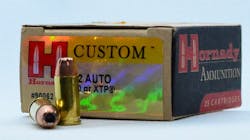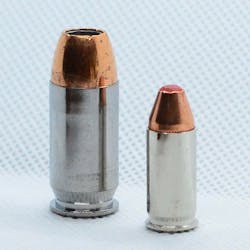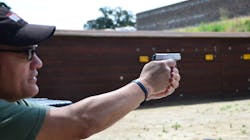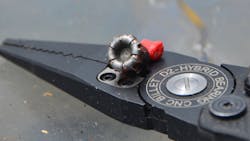The Round That Makes the Mouse Roar
In my article “12 Rules of Off Duty Conduct” (Law Enforcement Technology, February 2006), rule 10 was “carry the most effective weapon the wardrobe allows.” When the wardrobe is shorts and a t-shirt, this may be a viable option.
I can hear the jokes already: “.32 Auto is the caliber I carry when I’m not armed. It’s more effective to throw the gun than shoot the bullet.” The truth is, not every wardrobe will allow for an effective caliber. If it was always possible to carry an effective caliber, my everyday carry would be a .308. On one hand, some would consider it irresponsible to recommend a 32 Auto. On the other, it is a viable component in the off duty toolbox.
When it comes to using a .32 Auto, I prefer the words of Evan Marshall, co-author of the definitive studies Handgun Stopping Power and Street Stoppers: “We need to remember that while ammunition selection is important, it will never negate the need for superior tactics and marksmanship.”
The .32 Auto is rumored to be one of the widely used cartridges worldwide
The .32 Auto was originally designed by John M. Browning for the Browning No. 1 pistol. The cartridge designation is often called the 7.65mm Browning, 7.65 x 17 or the ,32 ACP (my favorite, since it stands for Automatic Colt Pistol).
.32 Auto guns typically are double action only, and usually blowback design. These features allow for short actions and simple engineering, allowing for thin, uncomplicated operation. A .38 special may be a more effective cartridge, but I found that I can put down accurate fire more rapidly with a pocket .32 Auto that takes up half the space, even with cartridges that may be considered a bit spicy for this caliber.
The blowback design is reliable, but it relies on the weight of the slide to keep the chamber closed during the firing cycle. Hornady Critical Defense rounds use nickel-plated brass, which is smoother than standard brass, adding to the reliability equation.
The .32 Auto should never be considered an effective caliber for defensive purposes. Rather, it should be considered a choice when other choices are impractical. The new Hornady Critical Defense .32 Auto cartridge adds a little more practicality to the choice.
Time to pull the trigger
Our test gun was a North American Arms .32 Auto, a perfect gun for trauma plate carry. This is a pocket gun with an OAL of 4.38”. I often carry the NAA .380 version. Up until I tested the gun, I thought they were the same size. The NAA .32 is smaller and much lighter. Magazines come with flat, extended, and finger rest base plates. I recommend that those with normal-sized hands use the flat base plate mags only when necessary. There’s only enough room for a couple of fingers on this gun. It doesn’t pitch or twist in the hand under recoil that much, even with the limited grip.
The 6+1 capacity NAA .32 is made of stainless steel with textured rubber grips. There is no missing the quality in the construction or the simplicity of the design. These are straight blowback guns, with fixed barrels and long pull double-action triggers. They are easy to clean and maintain. I find the “channel style” fixed blade sights to be a little small, but they are indestructible, like the rest of the gun. NAA’s Custom Shop will remedy this more cheaply than one would think. Disassembly is simple, even though my big hands get in the way.
We had borrowed this NAA .32 from a friend. When we got done with the test, I was thinking of adding to my NAA collection. The quality of North American Arms firearms is astounding, especially considering the price. I have several, and one of them is with me all the time, regardless of what I am doing.
I had a chance to test a KelTec P32, a polymer .32 Auto, a few years back. This is one of the smallest and lightest centerfire pistols on the market today. KelTec users are usually well-informed armed citizens and KelTec, under founder and designer George Kellgren, takes a unique approach. Their guns are deliberate designs, aimed at the concealed carry market. KelTec makes most of their gun parts available to the end user, and there are user groups that can help with general questions. The prices for parts are quite reasonable. They have created an entire market designed to empower the end user. On the P32, some things are so simple that the person who practices regularly can quickly inspect and keep a KelTec running in almost any environment. For example, the P32 extractor is mounted externally so it can be removed and replaced without further disassembly. I have often wondered when a prominent world military power will ever take the lead and adopt a KelTec.
On the range, we started with Hornady’s .32 Auto 60 grain FTX cartridge. In the short-barreled Guardian, it chronographed an average 950 fps. This performance was good for a 32, but we had a surprise coming.
We chronographed the 60-gr FTX Critical Defense round. It averaged 1,050 fps out of the 2.19” barrel of the Guardian. We shot enough rounds through the chronograph screens to confirm this performance. Hornady specs this cartridge at 133 ft.-lbs. at 100 fps. Obviously, 1,050 fps kicks it up a little.
One of the reasons that the effectiveness of the .32 Auto is questionable is the velocity. Anything under about 900 fps will not consistently expand a hollow point. If the hollow point expands at that velocity, adequate penetration is questionable. We usually tell users to use jacketed bullets and rely on penetration and accuracy.
The 60-gr FTX Critical Defense expanded reliably, all the way to 150%, in bare gelatin. The average penetration with the fully expanded FTX bullet was 12.5 inches in Clear Ballistic gelatin, with zero bullet weight loss. Critical Defense bullets have a Flex Tip, a polymer plug that prevents materials from the target from clogging the hollow point and affecting the reliability of the bullet. In my experience with all FTX bullets in all calibers, I have found that they are completely predictable, in most materials. In .32 Auto, I have never recorded such consistency in ballistic gelatin.
Hornady .32 Auto FTX Critical Defense cartridges come in 25 round boxes. This is the cartridge that can make the mouse gun roar.

Officer Lindsey Bertomen (ret.), Contributing Editor
Lindsey Bertomen is a retired police officer and retired military small arms trainer. He teaches criminal justice at Hartnell College in Salinas, California, where serves as a POST administrator and firearms instructor. He also teaches civilian firearms classes, enjoys fly fishing, martial arts, and mountain biking. His articles have appeared in print and online for over two decades.







